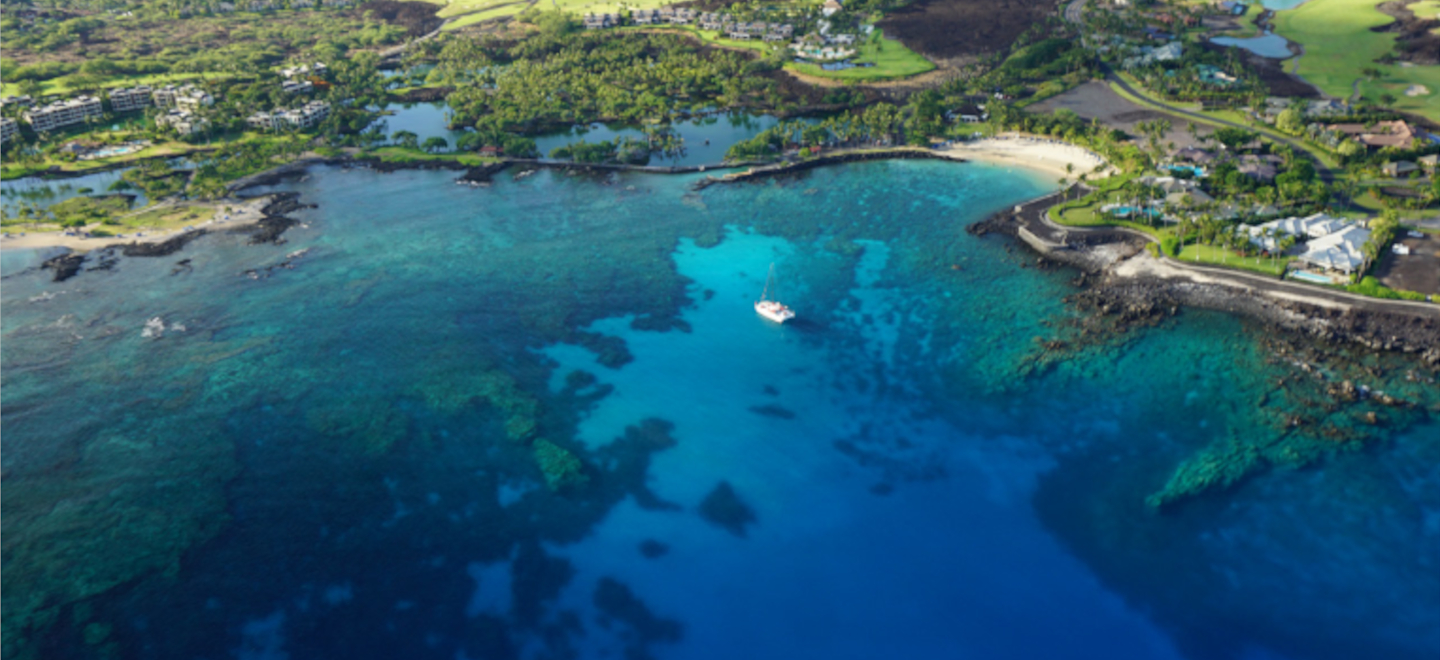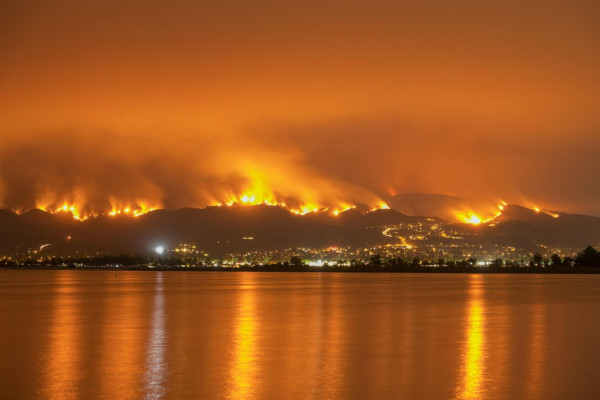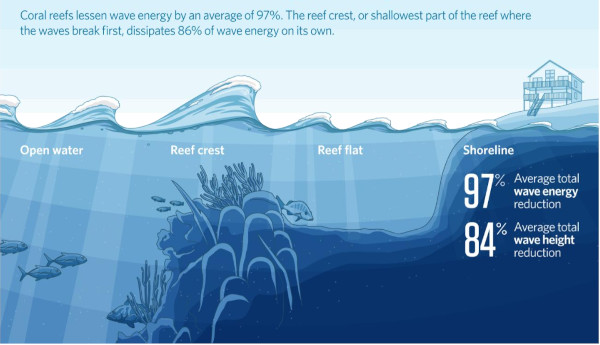How do we increase climate resilience in ways that work for people and nature?

Resort on coast in Hawaii with coral reef. © Chad Wiggins | TNC
By Tamaki Bieri and Alyssa Mann
In the U.S., the Federal Emergency Management Agency (FEMA) is responsible for responding to natural disasters -- like floods and wildfires -- and providing technical and financial hazard mitigation support. This support is primarily distributed as grant funding through FEMA’s Hazard Mitigation Assistance (HMA) programs.
FEMA spends billions of dollars on hazard mitigation assistance to communities to reduce or eliminate long-term risk, and has recently begun placing much greater emphasis on proactive investments before disasters occur. The 2018 Disaster Recovery Reform Act (DRRA), which passed in Congress with overwhelming bipartisan support, significantly increased the amount of funding available annually for pre-disaster mitigation.
FEMA seeks cost-effective solutions to mitigate disaster costs and impacts now and into the future. Nature-based solutions (NBS) utilize natural features and processes to promote resilience and adaptation. NBS for hazard mitigation support coastal resilience via the critical socioecological co-benefits associated with natural ecosystems. FEMA has steadily shifted many of its policies to better support the implementation of NBS.

FEMA hazard mitigation grants can address nature-based solutions to help reduce risk of catastrophic wildfires. © Ben Jiang /TNC Photo Contest 2019
FEMA and TNC share an interest in maximizing and facilitating the use of expanded mitigation dollars for nature-based strategies.
In June of 2019, TNC California formally partnered with FEMA Region 9 to develop resources to help communities navigate FEMA programs and advance projects that incorporate nature-based solutions and natural infrastructure to reduce hazard risk and to expand the use of FEMA Hazard Mitigation Assistance funding to support these strategies.
See all TNC-FEMA reports and Related Products below.
Climate change poses severe threats to coastal communities and the ecosystems on which they depend. Warming ocean temperatures increase the magnitude and frequency of storm events and cause back-to-back coral bleaching events, allowing less time for recovery amidst these threats. Coral reef ecosystems in the United States support fisheries, tourism, and coastal protection. The complex and stable structure of coral reefs protects against natural hazards by reducing wave energy. However, as reefs degrade, their effectiveness decreases. There is a clear need for active hazard mitigation actions to retain the critical ecosystem services of coral reefs.

The complex and stable structure of coral reefs protects against coastal flooding by reducing wave energy by 97%. Traditionally, active coral restoration aims to return coral reef ecosystems to a thriving state, with the goal of increased species and genetic diversity. The same methods can be used to serve as a robust hazard mitigation strategy in the form of coral reef restoration for risk reduction (CR4). CR4 aims to increase the structural integrity and complexity of coral reef ecosystems to attenuate wave energy and reduce coastal flooding.
To advance these efforts, TNC and partners assessed the feasibility of accessing federal hazard mitigation dollars for CR4 by selecting a U.S. coral jurisdiction within FEMA Region 9. For the study, they evaluated the technical feasibility, community buy-in, and cost-effectiveness of CR4 projects at 15 sites on Maui, analyzed the flood reduction benefits of coral reefs using FEMA’s Flood Assessment Structure Tool (FAST), and conducted a preliminary benefit-cost analysis.
The preliminary results show that CR4 is a cost-effective hazard mitigation strategy. However, the lack of rigorous National Structure Inventory (NSI) data will be a limiting factor for several jurisdictions, and there is need for stronger alignment between hazard mitigation and coral management priorities for the coral jurisdictions in FEMA Region 9. Further, coral restoration operations will need to establish CR4 best practices and techniques. Finally, unanticipated or unallowable project costs may limit the term and scale of future projects, and cost share requirement can be cost prohibitive, especially for lower resourced communities.
Partnerships like this with FEMA allow us to move closer to our shared interest in maximizing and facilitating the use of expanded mitigation dollars for nature-based strategies. Partners on this study included the Coastal Science and Policy Program at UC Santa Cruz (UCSC), and Radbridge LLC (formerly Earth Economics). View the full report, appendix, key takeaways and Maui case study.
The Nature Conservancy, radbridge, Earth Economics
FEMA increasingly recognizes and emphasizes the role of nature-based solutions (NBS) for building community resilience to hazards like flood, wildfire, and drought, and the agency has made remarkable…Taylor-Burns, R., Heard, S., Beck, M. W.
There is growing evidence for the beneficial role that wetlands can play in reducing flood risk, but in many urban estuaries, coastal development has resulted in dramatic habitat loss and…The Nature Conservancy
A 2022 report, Learning to Live with Fire in Forest Communities, highlights the science and benefits of fire-resilient community design. TNC partnered with key stakeholders in the…The Nature Conservancy, FEMA, Nonlinear Ventures, radbridge, Earth Economics
To address the increasing risk of catastrophic flooding, wildfire and other climate-related threats, communities are pursuing nature-based solutions (NBS) and seeking FEMA hazard mitigation funds to…UC Santa Cruz (Austen E. Stovall, Michael W. Beck), The Nature Conservancy (Alyssa Mann, Tamaki Bieri), Radbridge/formerly Earth Economics (Johnny Mojica, Rowan Schmidt)
Climate change poses severe threats to coastal communities and the ecosystems on which they depend. Warming ocean temperatures increase the magnitude and frequency of storm and coral bleaching events,…The Nature Conservancy, Earth Economics
FEMA requires that hazard mitigation projects must be cost-effective to the federal government, as demonstrated in a Benefit-Cost Analysis (BCA), which compares the present value of a project’s…The Nature Conservancy, AECOM
With increase in devasting storms and wildfires due to climate change, we need solutions to help mitigate the impact. Traditionally, “gray” or “hard” infrastructure…Charlotte Stanley, Alyssa Mann, Walter Heady
The United States operates thousands of military installations in the U.S. and worldwide, worth about $1.2 trillion. These facilities are where personnel train and test weaponry, with…Walter Heady, Alyssa Mann, Stacey Solie, Bob Battalio, James Jackson, Kendall Lousen, and Bob Barnes
The U.S. Congress and the Department of Defense (DoD) have determined that climate change is a threat to national security and have required military installations to develop plans to improve the…Alyssa Mann, Walter Heady, Charlotte Stanley
TNC and the United States Navy partnered together to prepare for the impacts of climate change on Naval Base Ventura County (NBVC), Point Mugu in California. NBVC is a critical and strategic asset of…Alyssa Mann, Walter Heady, Charlotte Stanley